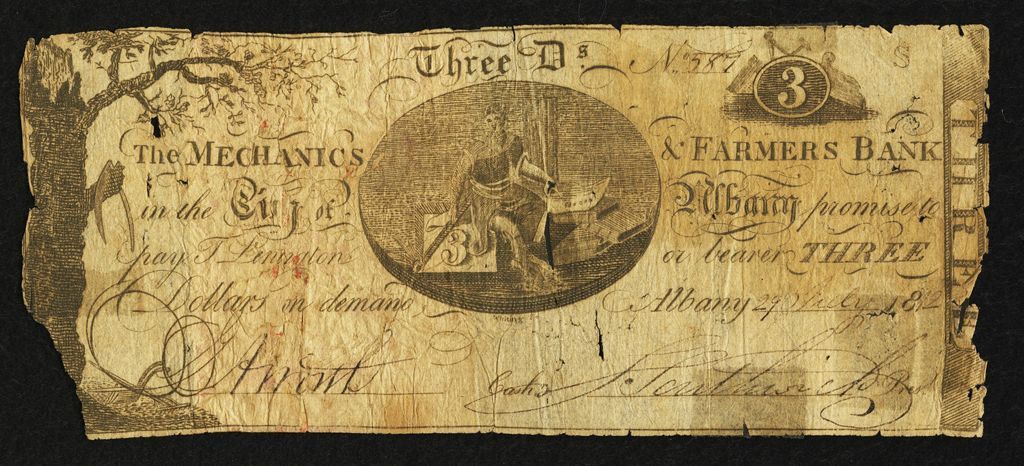Another obsolete counterfeit test.
Here are two notes from the Mechanics and Farmers Bank of Albany, NY. Although they certainly have the same plate letter, S, they are obviously different.
So is one a counterfeit, both genuine, or both counterfeit?


So is one a counterfeit, both genuine, or both counterfeit?


Bernie
Always looking for material from the Niagara river region.
0
Comments
An S plate number seems quite unusual. Obsolete notes were typically printed in sheets of four. If that's the case here, this would have to be from the fifth plate produced -- or one extremely large plate of at least 20 notes. I've never come across such a thing, so I wonder if the S indicates something else.
Montani Semper Liberi (Mountaineers are always free)
I will comment on the plate letter. Not unusual on early notes to use all the letters, two letters or a letter and number combination. These were printed 4 to a sheet.
I think the bottom note is counterfeit. There is too much difference in the leaves and branches between the notes. The bottom note looks crudely engraved and the portrait is bad too. I think the upper is genuine but I would like to compare it with another known genuine note to be sure.
Bernie
Always looking for material from the Niagara river region.
My collection spreadsheet shows that I have four different $3s from this bank, two C24s and two C28s.
Yes, the bottom note is counterfeit. This note is from the same plate as one of my counterfeits, acquired from Claud Murphy in 1993. The engraving is quite crude and this should be easily identified as a counterfeit.
But what about the top note? That one is much more of a challenge.
According to Haxby, the genuine note is supposed to have both the Whiting and Lemet imprints, but since that info is in parenthesis, this info is presumed and not confirmed. None of the three notes have both imprints, so is the top Berny note counterfeit or genuine?
Another comment about the two imprints. One is the engraver, the other the printer. This only happens on some earlier obsoletes. By the mid 1820s, engraving and printing was nearly always done by the same firm, probably for security reasons. Two imprints on post 1857 notes occurs more frequently for different reasons-the acqustion by American Bank Note Company.
Edited to add: I just noticed that the 1848 and 1850 dated $5s that I posted below also have two imprints-one for the engraver, Fairman, Draper, Underwood and another "Printed by J.E. Gavit & Co. Albany", as FDU didn't exist anymore by 1848-50.
RIP Mom- 1932-2012
Most obsolete notes are engraved and printed by a single company.
The first pair of $5’s: Hard to tell due to the condition of the notes and low-resolution scans. The counters don’t look very symmetric, especially the C plate-note. The A plate is an April Fool’s note. The C-plate “FIVE” looks very bad. Looks like both (Plate A and C) are C94 and not G94.
The bottom pair of $5’s: The bottom one (1862) with the ABNCo monogram is NY-75-G116a while the earlier one is G116-SENC.
The bottom 3 genuine notes have the same handwritten signature of “T Olcott” (pres) and the large cashier’s “Olcott.” The “Tho W Olcott” signature on the 1850 $5 counterfeit is very similar to the one on the $1 counterfeit posted at the top of this thread, only 31 years later.
Regarding your statement: “And the Haxby note may be different than either of the two examples shown by Berny.” Why? To me, the first note that I posted (and one of yours) sure looks like the Haxby counterfeit note (C24).
Bottom line: Given the poor condition/scans of most of these kinds of notes, the help given by the Haxby books is crucial. Remember that not only did he see a huge number of notes, he also extensively used counterfeit detectors to arrive at much of the information that he presents, even though some was not personally verified via actual notes seen. Unfortunately Bowers’ new tomes don’t seem to provide a solution. Many pretty colored pictures but little information added regarding this subject. Hopefully the SPMC online archives will fill the holes. It is up to us to help establish more complete information than Haxby could in 1988.
Bernie
Always looking for material from the Niagara river region.
We are in 100% agreement on the last five notes that I posted, which is reassuring and what I would hope for.
I'll just add one observation that hasn't been mentioned. Note the difference between the last two uprights of the t's in Olcott's signature. The counterfeits are nearly always parallel, while on his genuine signature, they aren't.
Would you like to see other early counterfeits on this bank? I also have five different genuine fractional denominations, all unlisted in Haxby.
...
Would you like to see other early counterfeits on this bank? I also have five different genuine fractional denominations, all unlisted in Haxby.
Bernie
Always looking for material from the Niagara river region.